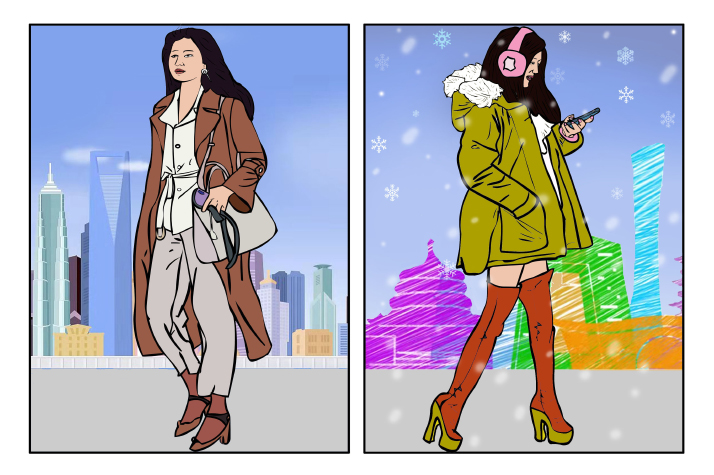| Lifestyle |
| Unveiling the soul of a Chinese metropolis… through shoes | |
|
|
 LI SHIGONG
F ashion fact #1: The earliest pair of leather shoes in existence in China is a 4,000-year-old pair of boots made from sheep hide, worn by a mummified female corpse discovered in the ruins of the ancient kingdom of Loulan, in the deserts of Xinjiang Uygur Autonomous Region. Fast forward to contemporary China. As I was on a flight from Shanghai soaring back into the capital that is Beijing, also the place I call "home," I wondered… What actually makes up the soul of a mega metropolis like the aforementioned dragons? Then I realized… The answer had been in front of me all along: shoes. Indeed, footwear. We're talking the sole of a city. High heels, Doc Martens, sneakers… Here's a step-by-step guide to the footprint of a mega city—the Beijing Boots vs. the Shanghai Stilettos. Fashion: There's a whole lot more to it than meets the eye. Let's kick off with Beijing, nicknamed Di Du (Imperial City). Which brings us to fashion fact #2: In the Qing Dynasty (1644–1911), established by the Manchu who were good at riding and shooting, military boots were adapted for civilian wear and also became part of the uniform for officials. Boots came in the two styles of pointed or square-toes, the former being for everyday wear, and the latter for court attendance. The soles of these boots were made from 32 layers of cloth and were later used in the making of the cloth shoes worn by the common people, which have since become known as one-thousand-layered shoes. Now you know. Beijing pavements often receive the heavy tread of its residents' too-cool-for-school boots. We find ourselves up north, where the climate is a bit rougher, a bit tougher. Dropping temperatures aside, there's a palpable sensation slightly ever so reinforced by the capital's beloved erhua—a phonological process that adds R-like sounds to certain words—and the "whatever" attitude it entails. The sturdy gear also accessorizes well with the vast distances one covers: You walk, a lot. The phrase "it's right around the corner" takes on a whole new meaning. Yet, like the serving of an iced black Americano, the city just "is." It's the capital; it's the core of a nation. And only the thickest of skin (or leather) can live up to its expectations. Enter: Shanghai, home to the aristocat pat, the more "refined" among the country's residents. Also known as Mo Du (or Magic City), this town is located a little bit more south on the Middle Kingdom's map, the weather is a bit warmer, its pavements a little more clickety-clack, its overall vibe a little more melodious, supported by the more dia tune of things, a dialect of almost saccharine sweetness—which couldn't get any further from the erhua end on the speech spectrum. It's all about the spell-binding charm of finance and fashion; image is everything. Some might even use the word zhuang (pretentious) when referring to the megalopolis, but we'll keep that on a side note. Fashion fact #3: The Hundred Shoes House (Bailutang) may be just a small personal museum in Shanghai, but is in fact the biggest ancient shoe museum in all of China. First built in 1992, it holds a vision of colorful ancient shoes collected by its owner Yang Shaorong over the course of decades. More than 1,500 pairs of different patterns and from different places and ages systemically show you the history and evolution of China's shoe culture. There you go. The urban dwelling is a bit more Parisian. Its narrow streets, the allure of the imposing 1920s and 30s ambassadorial architecture flanked by oversized off-the-beaten-path style trends. Like the serving of a bespoke cocktail, the city represents fascination and finesse; it's the shop window of China. And only the fairest feet of them all may enter its Magic Kingdom. After all, you need a pair of heels to live the high life. But remember, anywhere your soles may hit the vast landmass of China, there's one saying that applies to all souls: fan hou bai bu zou, huo dao jiu shi jiu. Take 100 steps after dinner, and you'll live to be 99. The author is an editorial consultant with Beijing Review Printed edition title: The Sole of a City Comments to dingying@bjreview.com |
|
||||||||||||||||||||||||||||
|